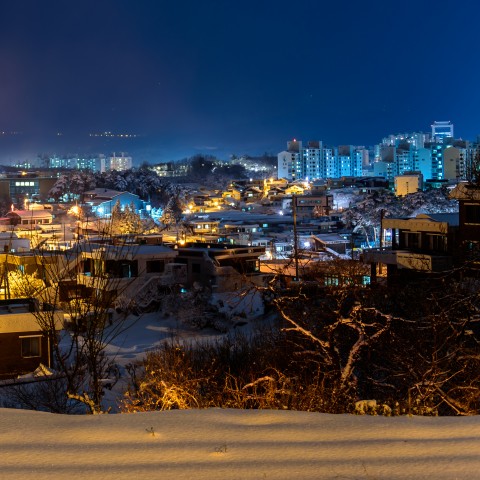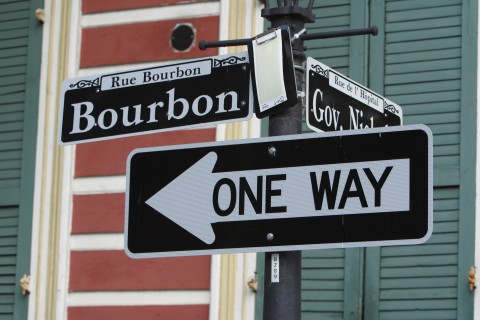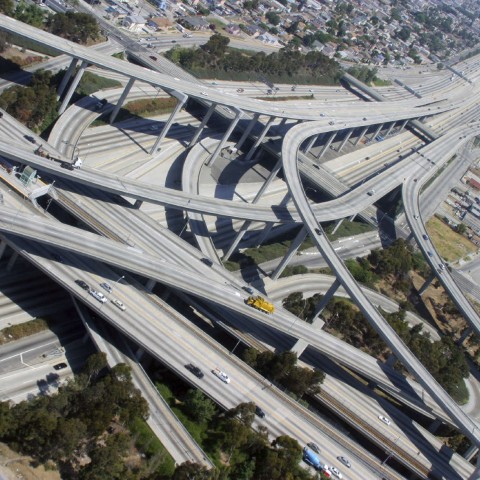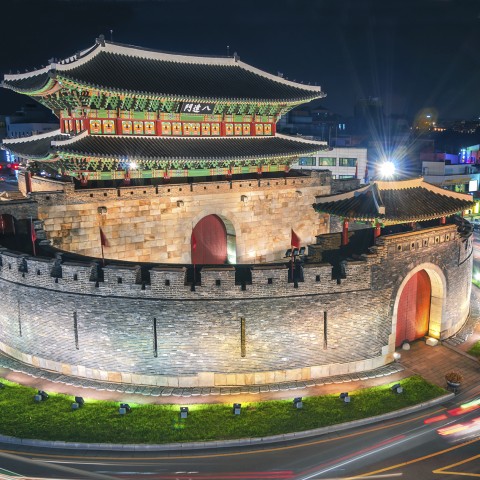
Knowing how to say left and right in Korean isn’t good enough if you want to really get around Korea. Let’s learn how to give directions in Korean with KoreanClass101!
Have you ever gotten lost in an unfamiliar city? In your own country, you can simply get in a taxi or ask someone for directions. But what would you do if this happens to you in a foreign country?
Many Koreans can speak English, but this doesn’t mean that everyone speaks English fluently like you do. Therefore, it’s important to learn some basic phrases and words for directions so that when you’re not sure where you are in Korea, you can easily converse with locals in their native language.
Don’t be afraid to make mistakes when practicing, because this is just a part of learning the language. Koreans will appreciate that you speak their language and they’ll definitely help you find the way.

Table of Contents
- On the Map
- On the Road (10 Basic Opposites)
- Directions in Korea Using Landmarks
- Must-Know Phrases for Asking for Directions
- Must-Know Phrases for Giving Directions
- How KoreanClass101 Can Help You with Korean
1. On the Map

1. Cardinal Directions in Korean
| Korean | Romanization | English |
| 동(쪽) | dong(jjok) | East |
| 서(쪽) | seo(jjok) | West |
| 남(쪽) | nam(jjok) | South |
| 북(쪽) | buk(jjok) | North |
2. Cardinal Direction Combinations
When you want to describe the location precisely, you can combine the four words above. For example, if you want to say “southwest,” combie 서 (seo) and 남 (nam) together, followed by 쪽 (jjok) which means “side/way.”Examples
- 북서쪽
bukseojjok
“Northwest side” - 남동쪽
namdongjjok
“Southeast side”
3. Talking about Directions
- [시티]은/는 [나라]의 [방향]에 위치해있다.
[Siti]eun/neun [nara]ui [banghyang]e wichihaeitda.
“[City] is in the [direction] part of Korea.”
Examples
- 부산은 한국의 남쪽에 위치해있다.
Busaneun hangugui namjjoge wichihaeitda.
“Busan is in the south(ern) part of Korea.” - 서울은 한국의 중서부에 위치해있다.
Seoureun hangugui jungseobue wichihaeitda.
“Seoul is in the midwest(ern) part of Korea.”
2. On the Road (10 Basic Opposites)
If you need to give or receive driving directions in Korean, here are some basic opposites you should know!
1.앞 (ap ) ↔ 뒤 (dwi)
A- Meaning
B- Examples
- 아파트는 슈퍼 앞에 있어요.
Apateuneun syupeo ape isseoyo.
“The apartment is in front of the supermarket.” - 아파트는 병원 뒤에 있어요.
Apateuneun byeongwon dwie isseoyo.
“The apartment is at the back of (behind) the hospital.”
2. 오른쪽 (oreunjjok) ↔ 왼쪽 (oenjjok)
A- Meaning
There are two ways to say “right” and “left” in Korean. 오른쪽 (oreunjjok) / 왼쪽 (oenjjok) and 우회전 (uhoejeon) / 좌회전 (jwahoejeon). The meanings are exactly the same.
B- Examples
- 오른쪽에 보이는 저 건물이 우리 학교야.
Oreunjjoge boineun jeo geonmuri uri hakgyoya.
“That building that you see to the right is my school.” - 저기 횡단보도에서 오른쪽으로 돌아주세요.
Jeogi hoengdanbodoeseo oreunjjogeuro dorajuseyo.
“Please turn to the right at that pedestrian road.”
3. 우회전 (uhoejeon) ↔ 좌회전 (jwahoejeon)
A- Meaning
우회전 (uhoejeon) and 좌회전 (jwahoejeon) are the same as 오른쪽 (oreunjjok) and 왼쪽 (oenjjok), respectively. Taxi drivers use these two words a lot, so it’s important to memorize them. Knowing taxi directions in Korean is essential if you want to get anywhere!
B- Examples
- 두 번째 신호등에서 우회전해주세요. (formal)
Du beonjjae sinhodeungeseo uhoejeonhaejuseyo.
“Please turn right at the second traffic light.” - = 두 번째 신호등에서 오른쪽으로 가주세요. (formal)
Du beonjjae sinhodeungeseo oreunjjogeuro gajuseyo.
“Please turn right at the second traffic light.” - 다음 교차로에서 좌회전해주세요. (formal)
Daeum gyocharoeseo jwahoejeonhaejuseyo.
“Please make a left at the next intersection.” - = 다음 교차로에서 왼쪽으로 가주세요. (formal)
Daeum gyocharoeseo oenjjogeuro gajuseyo.
“Please make a left at the next intersection.”
4. 가깝다 (gakkapda) ↔ 멀다 (meolda)
A- Meanings
B- Examples
- 여기서 가장 가까운 지하철역은 어디입니까? (formal)
Yeogiseo gajang gakkaun jihacheollyeogeun eodiimnikka?
“Where is the nearest subway station from here?” - 강남역에서 역삼역까지는 멀지 않아요. (formal)
Gangnamyeogeseo yeoksamyeokkkajineun meolji anayo.
“It’s not far from Gangnam Station to Yeoksam Station.”
5. 바로 앞에 (baro ape) ↔ 바로 뒤에 (baro dwie)
A- Meanings
- 바로 앞에 (baro ape) “right in front”
- 바로 뒤에 (baro dwie) “right behind”
B- Examples
- 기사님, 저기 바로 앞에 세워주세요. (formal)
Gisanim, jeogi baro ape sewojuseyo.
“Driver, please pull up in front of there.” - 기사님, 저기 슈퍼 바로 뒤에서 세워주세요. (formal)
Gisanim, jeogi syupeo baro dwieseo sewojuseyo.
“Driver, please pull up right behind the supermarket.”

3. Directions in Korea Using Landmarks
1. 공항 (gonghang) “airport”
Examples
- A: 아저씨, 인천공항으로 가주세요.
A: Ajeossi, incheongonghangeuro gajuseyo.
A: “Please go to Incheon Airport.” - B: 국내선이이요, 국제선이요?
B: Gungnaeseoniiyo, gukjeseoniyo?
B: “To the domestic or international terminal?” - A: 국제선으로 가주세요.
A: Gukjeseoneuro gajuseyo.
A: “To the international terminal.”
2. 전철역 (jeoncheollyeok) “subway station”
- Getting around by subway is fairly easy in Korea. You can check out this map of the Seoul subway.
Examples
- A: 여기서 이수역까지 가려면 어떻게 가면 되나요?
A: Yeogiseo isuyeokkkaji garyeomyeon eotteoke gamyeon doenayo?
A: “How do I go to Isu Yeok from here?” - B: 2호선 타고 4정거장 가면돼요.
B: Ihoseon tago 4jeonggeojang gamyeondwaeyo.
B: “Just take the number 2 line and go 4 stops.”
3. 공원 (gongwon) “the park”
Examples
- A: 한강공원에서 할수 있는게 뭐있을까?
A: Hanganggongwoneseo halsu inneunge mwoisseulkka?
A: “What kind of activities can we do at Hangang Park?” - B: 자전거 빌려서 한바퀴 돌 수 있는데, 해볼래?
B: Jajeongeo billyeoseo hanbakwi dol su inneunde, haebollae?
B: “You can rent a bicycle and cycle around the park. Do you want to try?”
4. 호텔 (hotel) “hotel”
- Here are some more words related to accommodation:
- 여관 (yeogwan) — “inn”
- 게스트하우스 (geseuteuhauseu) — “guest house”
- 에어비엔비 (eeobienbi) — “Airbnb”
Examples
- A: 어디로 갈까요?
A: Eodiro galkkayo?
A: “Where do you want to go?” - B: 신라호텔로 가주세요.
B: Sillahotello gajuseyo.
B: “Please take me to Silla Hotel.” - A: 네.
A: Ne.
A: “Okay.”
5. 병원 (byeongwon) “hospital”
Examples
- A: 영어가능한 병원으로 가고 싶은데, 어디가 좋을까요?
A: Yeongeoganeunghan byeongwoneuro gago sipeunde, eodiga joeulkkayo?
A: “I’d like to go to an English-speaking hospital. Do you know any places?” - B: 순천향대학병원이 좋아요. 통역사가 많이 일하고 있거든요.
B: Suncheonhyangdaehakbyeongwoni joayo. Tongyeoksaga mani ilhago itgeodeunyo.
B: “I recommend Soonchunhyang University Hospital. There are many interpreters working there.”
6. 은행 (eunhaeng) “bank”
- “To withdraw money” is 돈(을) 뽑다 (don(eul) ppopda). This phrase is often used, so it’s good to memorize it.
Examples
- A: 돈 좀 뽑고 싶은데 은행이 어디에 있지?
A: Don jom ppopgo sipeunde eunhaengi eodie itji?
A: “I want to withdraw some money. Where is the bank?” - B: 아, 저 횡단보도 앞에 바로 있네, 가자!
B: A, jeo hoengdanbodo ape baro inne, gaja!
B: “Ah, there is one right in front of the pedestrian road. Let’s go!”
7. 쇼핑몰 (syopingmol) “shopping mall”
- In Korea, if you pay with cash, you’ll receive a greater discount than you will by paying with a credit card. This is true for places such as 지하상가 (jihasangga), or the “underground shopping mall.”
- If you go to a department store, or many other shops, they offer tax-free shopping.
Examples
- A: 쇼핑몰 어디로 가면 좋을까?
A: Syopingmol eodiro gamyeon joeulkka?
A: “Which shopping mall should we go to?” - B: 동대문? 홍대? 아니면 명동이지 않을까?
B: Dongdaemun? Hongdae? animyeon Myeongdongiji aneulkka?
B: “We should go to either Dongdaemoon, Hongdae, or Myeongdong?”
8. 지하상가 (jihasangga) “underground shopping mall”
- You can buy a lot of stuff here, such as clothing, accessories, colored lenses, and so on, for a cheap price. However, these shops don’t offer tax-free shopping, and oftentimes they’ll charge ten percent more if you use a credit card. So do carry some cash with you if you want to go.
Examples
- A: 현금가 1만원이라는 뜻이 뭐야?
A: Hyeongeumga ilmanwoniraneun tteusi mwoya?
A: “What does it mean by “Cash price 10,000 won?” - B: 아, 현금으로 내면 1만원이고, 카드로 내면 돈 몇천원 더 내야한다는 뜻이야.
B: A, hyeongeumeuro naemyeon ilmanwonigo, kadeuro naemyeon don myeotcheonwon deo naeyahandaneun tteusiya.
B: “That means if you pay by cash, it cost 10,000 won, but there will be a sub-charge if you pay by credit card.”
9. 육교 (yukgyo) “a pedestrian bridge”
Examples
- A: 육교로 건너가서 택시 타자.
A: Yukgyoro geonneogaseo taeksi taja.
A: “Let’s cross the road by the pedestrian bridge and catch a taxi.”
10. On a Road
1. 교차로 (gyocharo) “intersection”
- There are many kinds of intersections in Korea. Check out this page to see the list.
Examples
- 차들은 다른 방향으로 들어 가기 위해 교차로로 갑니다.
Chadeureun dareun banghyangeuro deureo gagi wihae gyocharoro gamnida.
“Cars enter the intersection to change directions.”
2. 횡단보도 (hoengdanbodo) “pedestrian crossing”
Examples
- 횡단보도에서 내려 주실래요?
Hoengdanbodoeseo naeryeo jusillaeyo?
“Can you pull over at the crosswalk?”
3. 신호등 (sinhodeung) “traffic light”
- Be careful when you cross the road in Korea. Many drivers ignore the traffic light, and they don’t slow down when the light turns yellow on its way to red.
Examples
- 한국에는 신호등을 무시하고 운전하는 택시운전사가 많아요.
Hangugeneun sinhodeungeul musihago unjeonhaneun taeksiunjeonsaga manayo.
“There are many taxi drivers who ignore the traffic light and continue driving in Korea.”
4. 주유소 (juyuso) “gas station”
- “Top it up” is 만땅이요 (manttangiyo) in Korean. This phrase is only used when you’re at a gas station.
Examples
- 주유소를 찾고 있는데요, 어디에 있나요?
Juyusoreul chatgo inneundeyo, eodie innayo?
“I’m looking for a gas station. Where is it?”
5. 휴게소 (hyugaeso) “rest area”
Examples
- 운전 좀 했더니 피곤하네. 휴게소에 들러서 뭐 좀 먹고 가자.
Unjeon jom haetdeoni pigonhane. hyugesoe deulleoseo mwo jom meokgo gaja.
“I feel tired after driving for awhile. Let’s have a bite to eat at the rest area.”
6. 차선 (chaseon) “lane”
Examples
- 차선이 이렇게 아무리 많아도 교통체증이 심하네.
Chaseoni ireoke amuri manado gyotongchejeungi simhane.
“There are so many lanes, but still so much traffic.”
11. In a Structure/Building
Here’s a list of additional vocabulary for you to memorize.
| Korean | Romanization | English |
| 화장실 | hwajangsil | restroom |
| 엘리베이터 | ellibeiteo | elevator |
| 게이트 | geiteu | gate |
| 주차장 | juchajang | parking area |
| 비상구 | bisanggu | emergency exit |
| [이름] 빌딩 | [ireum] bilding | [name] building |
| 미팅룸 | mitingnum | meeting room |
| 수영장 | suyeongjang | swimming pool |

4. Must-Know Phrases for Asking for Directions

Now that we’ve looked at essential vocabulary, let’s practice asking for directions in Korean!
1. Polite Phrases to Start the Question
- 저기 죄송한데요. (Jeogi joesonghandeyo.)
- 실례합니다. (Sillyehamnida.)
- 죄송한데요. (Joesonghandeyo.)
These three phrases have the same meaning: “excuse me.” There’s not much difference in their meanings, so you can choose the one that feels comfortable to you.
2. Where is…?
- [장소]은/는 어디에 있습니까? (formal – business level)
[Jangso]eun/neun eodie itseumnikka?
“Where is [location]?” - [장소]은/는 어디에 있나요? (formal – friendly)
[jangso]eun/neun eodie innayo?
“Where is [location]?” - 이 근처에 [장소]있나요?
I geuncheoe [jangso]innayo?
“Is there [location] near here?”
Example
- A: 화장실은 어디에 있나요?
A: Hwajangsireun eodie innayo?
A: “Where is the restroom?” - B: 왼쪽에 바로 있어요.
B: Oenjjoge baro isseoyo.
B: “It’s right there on the left.” - A: 이 근처에 슈퍼마켓있나요?
A: I geuncheoe syupeomakesinnayo?
A: “Is there a supermarket around here?” - B: 바로 직진해서 횡단보도 건너면 바로 세븐일레븐이 있어요.
B: Baro jikjinhaeseo hoengdanbodo geonneomyeon baro sebeunillebeuni isseoyo.
B: “Just go straight, then cross the pedestrian road. There will be a Seven-Eleven.”
3. How do I get to…?
- [장소]는 어떻게 가나요?
[Jangso]neun eotteoke ganayo?
“How do I go to [location]?” - [장소]는 여기서 어떻게 가나요?
[Jangso]neun yeogiseo eotteoke ganayo?
“How do I go to [location] from here?”
If your Korean is good enough to hold a conversation, it’s good to ask for more-detailed directions. When you say one of these sentences, people will explain the directions in detail. Or if you’re lucky, they’ll take you to the right bus stop/subway station.
Examples
- A: 실례합니다, 서울역은 어떻게 가나요?
A: Sillyehamnida, seoullyeogeun eotteoke ganayo?
A: “Excuse me, how do I go to Seoul Station?” - B: 서울역이요? 여기서 1호선 지하철 타고 가면 금방이예요.
B: Seoullyeogiyo? Yeogiseo 1hoseon jihacheol tago gamyeon geumbangiyeyo.
B: “Seoul Station? The fastest way is to take the Line 1 subway from here.” - A: 죄송한데요, 가로수길은 여기서 어떻게 가나요?
A: Joesonghandeyo, Garosugireun yeogiseo eotteoke ganayo?
A: “Excuse me, how do I go to Garosu Street from here?” - B: 가로수길은 버스타고 가는게 제일 나아요. 잠시만요, 확인해드릴께요.
B: Garosugireun beoseutago ganeunge jeil naayo. Jamsimanyo, hwaginhaedeurilkkeyo.
B: “It’s better to take a bus to go to Garosu Street. Hold on, let me check the way for you.”
4. How far is …?
- [장소]는 얼마나 먼가요?
[Jangso]neun eolmana meongayo?
“How far is [location]?” - 여기서 [장소]까지는 얼마나 먼가요?
Yeogiseo [jangso]kkajineun eolmana meongayo?
“How far is [location] from here?” - [장소1]에서 [장소2]까지 얼마나 걸리나요?
[Jangsoil]eseo [jangsoi]kkaji eolmana geollinayo?
“How long does it take to get to [location2] from [location1]?”
Examples
- A: 강남역에서 교보문고까지 얼마나 걸리나요?
A: Gangnamyeogeseo Gyobomungokkaji eolmana geollinayo?
A: “How long does it take to get to Kyobo Book Centre from Gangnam Station?” - B: 글쎄요, 강남역에서 걸어간다면 한 15분에서 20분정도 걸리겠네요.
B: Geulsseyo, gangnamyeogeseo georeogandamyeon han 15buneseo 20bunjeongdo geolligenneyo.
B: I’m not sure, but if you walk from Gangnam Station it will take about fifteen to twenty minutes.”
5. Courtesy Phrases to Thank People
-
감사합니다.
Gamsahamnida.
“Thank you.”
This phrase is the most-used method to thank someone after the conversation is over. If you want to expand a little, you can also say 네, 알겠습니다. 감사합니다 (Ne, algetseumnida. Gamsahamnida.). The translation is “I understand, thank you!”

Roads
5. Must-Know Phrases for Giving Directions

1. Street Phrases
| Korean | Romanization | English |
| 직진하면 | jikjinhamyeon | If you go straight |
| 유턴하면 | yuteonhamyeon | If you do a U-turn |
| 왼쪽/오른쪽으로 가면 | oenjjok/oreunjjogeuro gamyeon | If you go left/right |
| 우회전/좌회전하면 | uhoejeon/jwahoejeonhamyeon | If you go left/right |
2. For Buildings
| Korean | Romanization | English |
| # 층 | # cheung | #th floor |
| 밑으로 가다 | miteuro gada | To go down (by elevator/escalator) |
| 위로 올라가다 | wiro ollagada | To go up (by elevator/escalator) |
| 지하로 가다 | jiharo gada | To go to the basement |
3. To a Driver
You’ll find the phrases below very useful when you’re traveling in South Korea. Many taxis are equipped with a free interpreter service, and some taxi drivers can speak another language, the most popular languages being Japanese and English. Nevertheless, it’s good to memorize these taxi directions in Korean!Examples
- 계속 직진해주세요.
Gyesok jikjinhaejuseyo.
“Please continue straight.” - 서둘러주세요.
Seodulleojuseyo.
“Please speed up a bit.” - 조금 천천히 가주세요.
Jogeum cheoncheonhi gajuseyo.
“Please slow down the speed.” - ~에서 오른쪽/왼쪽으로 가주세요.
~eseo oreunjjok/oenjjogeuro gajuseyo.
“Please turn right/left from ~.” - ~에서 우회전/좌회전이요.
~eseo uhoejeon/jwahoejeoniyo.
“Please turn right/left from ~.” - 횡단보도에서 세워주세요.
Hoengdanbodoeseo sewojuseyo.
“Please pull over at the pedestrian road.”

6. How KoreanClass101 Can Help You with Korean
In this article, we looked at many different ways to ask for directions in Korean. If you’re interested in learning more vocabulary about the directions in Korean, you can challenge yourself by visiting our free vocabulary page, Position / Direction, to check out more words. KoreanClass101 also provides many direction-related study materials for free, so why not create a new account today and explore the website? Good luck with your Korean studies!
But before you go, let us know in the comments how you feel about asking and giving directions in Korean! Do you feel more confident now? Are there any Korean direction words you still want to know? We look forward to hearing from you!










